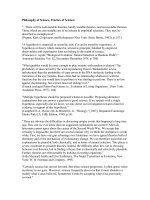Rocks – a rock is a collection of one or more minerals
Bạn đang xem bản rút gọn của tài liệu. Xem và tải ngay bản đầy đủ của tài liệu tại đây (3.11 MB, 9 trang )
Rocks – a rock is a collection of one or more minerals.
Ms. Hartnett's Earth
1
Rock facts
1. Most rocks have a number of minerals in common. In other
words, only a small number of minerals are very common.
2. Most rocks are heterogeneous. This means that they are made of
two or more different minerals and are not the same throughout.
3. Some (very few) rocks are homogeneous or monominerallic.
This means that they are made of only one type of mineral and
they are the same throughout.
4. Rocks are divided into 3 major classes. They are sedimentary,
igneous, and metamorphic.
5. Rocks are classified by how they formed or origin.
6. Structure, texture, and composition (what a rock is made of) help
us to figure out the environment that the rock formed in (origin).
Ms. Hartnett's Earth
2
Ms. Hartnett's Earth
3
Sedimentary Rocks – rocks that formed from the accumulation
of deposited rock particles, fragments, and organic material
underwater. (Remember, they are deposited in horizontal layers)?
There are 3 basic categories of sedimentary rocks:
1. Clastic – the rock fragments are lithified (glued) together to
form a rock. These rocks are made of different pieces stuck
together. Conglomerate and Breccia have the largest particles.
2. Crystalline/Chemical - rocks that formed from ions (smallest
particles) that were dissolved in the sea water. These rocks
usually form as the ocean water evaporates away and leaves
the dissolved minerals behind. These are also monominerallic.
3. Bioclastic/Organic – rocks formed from biologic products.
(Things that died and solidified together over time. Coal and
limestone are great examples.
Ms. Hartnett's Earth
4
Ms. Hartnett's Earth
5
Igneous Rocks – rocks formed from the cooling and
solidification of molten materials (magma). Whenever lava
cools, an igneous rock forms.
There are two sub-classes of igneous rocks:
1. Intrusive/Plutonic – igneous rocks that cooled and solidified
beneath the Earth’s surface (The magma cools underground).
These rocks take a very long time to cool because they are not on
the surface. Because they take a longer time to cool, they end up
having large crystals/grains.
2. Extrusive/Volcanic – igneous rocks that cooled and solidified on
the Earth’s surface. Lava on the surface cools to form igneous
rocks. These rocks cool very quickly and have very small
crystals/grains or none at all (glass).
Ms. Hartnett's Earth
6
Ms. Hartnett's Earth
7
Metamorphic Rocks – rocks that have been changed by the
action of heat and pressure from occurrences inside the Earth.
Metamorphic rocks were once sedimentary, igneous, or a
different type of metamorphic rock. Because of the heat
and pressure of magma coming in contact with rock, the
former rock changes into a new one.
The rock does not melt while it changes into a metamorphic, but
it almost does. It just deforms and distorts. What kind of rock
would form if rock melted and then re-cooled? ______________
There are two groups of metamorphic rocks:
1. Foliated – alignment of minerals in paper thin layers or bands.
2. Non-foliated – no alignment of minerals.
Ms. Hartnett's Earth
8
Ms. Hartnett's Earth
9









